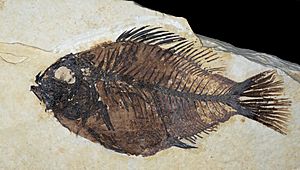Green River Formation facts for kids
The Green River Formation is a special group of rocks found on the eastern side of the Rocky Mountains. These rocks formed from mud and sand that settled at the bottom of ancient lakes. It's famous for its amazing fossils, which are incredibly well-preserved. Scientists call places with such great fossils a lagerstätte (say: LAH-ger-shta-tuh), which means 'storage place' in German.
The fossils in the Green River Formation tell us about a time long, long ago, between 53.5 and 48.5 million years ago. This time is called the Eocene Epoch. During this period, the climate slowly changed from very wet to a bit drier.
The rocks here are made of very thin layers, like pages in a book. Each pair of layers has a dark one and a light one. The dark layer formed during the warmer growing season, and the light layer formed in winter. Each pair of layers is called a varve, and it represents one year. These layers give us a continuous record of six million years of Earth's history!
The Green River Formation covers a large area named after the Green River, which flows into the Colorado River today. The formation is found in three separate areas, called basins, around the Uinta Mountains in northeastern Utah:
- A basin in northwestern Colorado, east of the Uinta Mountains.
- A larger basin in the southwest corner of Wyoming, north of the Uinta Mountains. This area was once a huge ancient lake called Lake Gosiute.
- Inside Lake Gosiute, there was a special spot called Fossil Lake in Fossil Butte National Monument, Wyoming. This place has incredibly well-preserved fish fossils. One part, called the "split fish layer," is about 1.8 meters (6 feet) thick. It's full of fish and other fossils. The rock easily splits along its layers, showing the fossils inside. This thin layer took about 4,000 years to form.
- The biggest basin is in northeastern Utah and western Colorado, south of the Uinta Mountains. This area was once a large lake called Lake Uinta.
Contents
What it was like long ago
The rocks in the Green River Formation contain many minerals that form when lake water evaporates. This suggests that the ancient lakes were very salty at times. This high saltiness helped preserve the animals and plants that died there.
Another important factor was the frequent falls of volcanic ash from nearby volcanoes. When ash covered dead plants and animals quickly, it protected them from rotting away.
Ancient Climate
The fossils found here tell us that the region was a low, warm, and wet area. It was a freshwater basin, meaning the lakes were not salty like the ocean. The climate was subtropical, similar to places like Florida today.
The Green River fossils show how the climate changed over time. It started out very moist and mild, warm enough for crocodiles to live there (crocodiles can't handle frost!). The lakes were surrounded by sycamore forests. As the lakes changed shape due to small movements in the Earth's crust, each part of the Green River Formation has its own unique story and timeline.
Oil Shale Deposits
The Green River Formation holds the largest oil shale deposits in the world. These rocks contain a huge amount of oil, estimated to be about 1.5 trillion US barrels! This shows just how much organic material (like tiny plants and algae) was buried here long ago. This organic material likely came from tiny living things called cyanobacteria, which grew very well in the warm, alkaline lake water.
Amazing Fossils
The amazing fossils in the Green River Formation formed in special conditions. The lake bottoms had very little oxygen, and the mud was made of fine carbonate particles. This lack of oxygen meant that bacteria couldn't break down dead plants and animals very quickly. Also, there were no scavengers (animals that eat dead things) because of the low oxygen.
Leaves from palms, ferns, and sycamore trees were covered by fine mud and preserved. You can even see where insects chewed on the leaves while they were still alive! Insects themselves were preserved whole, even their delicate wing membranes and the tiny parts spiders use to make silk.
The animals found as fossils include many kinds of fish, alligators, bats, turtles, dog-sized horses, and many different types of insects.
Images for kids
-
Heliobatis radians (a type of stingray) fossil from the Green River Formation.
-
A fossil crocodile lizard (Shinisauridae) preserved as a mineralized film.
-
A Stromatolite fossil from ancient Lake Gosuite. Stromatolites are layers formed by tiny bacteria.
See also
 In Spanish: Formación Green River para niños
In Spanish: Formación Green River para niños













